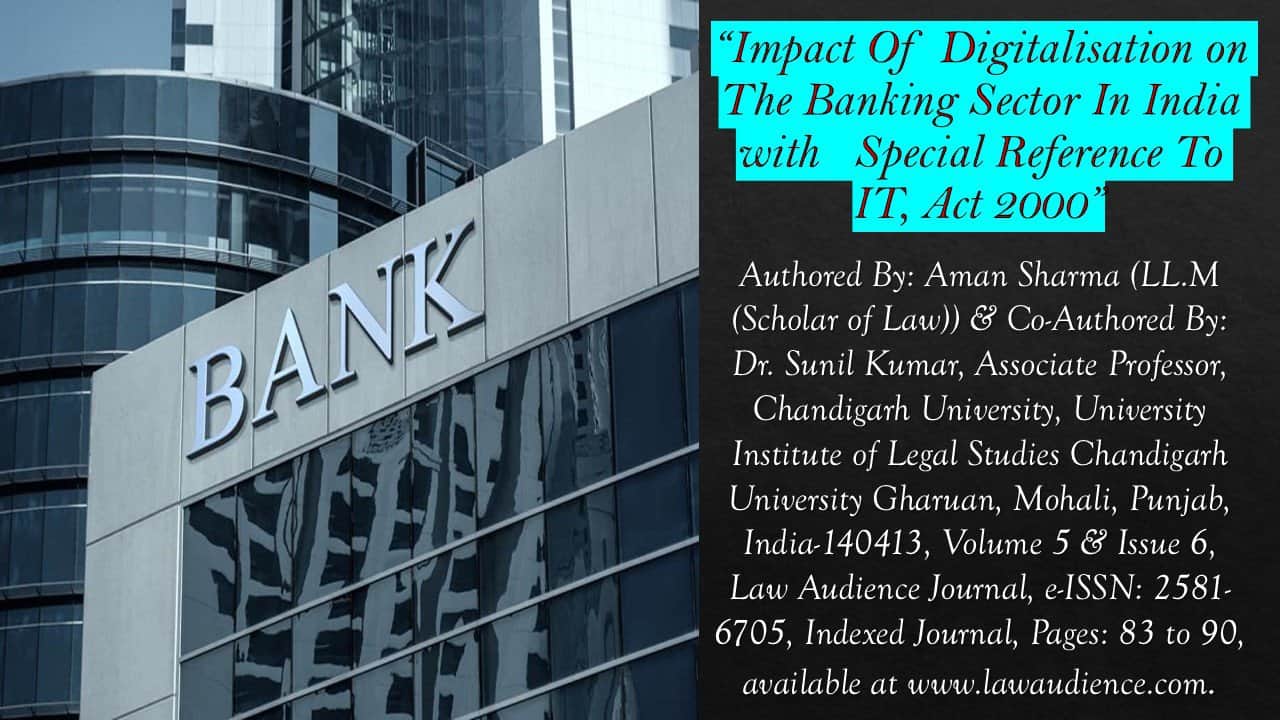Click here to download the full paper (PDF)
Authored By: Aman Sharma (LL.M (Scholar of Law)) & Co-Authored By: Dr. Sunil Kumar, Associate Professor, Chandigarh University, University Institute of Legal Studies Chandigarh University Gharuan, Mohali, Punjab, India-140413,
Click here for Copyright Policy.
ABSTRACT:
“A key component in the growth of a country’s economy is the financial system which plays a vital role in the development of the country through capital accumulation and technological progress by increasing savings rate, mobilizing and pooling savings, producing investment information, facilitating and encouraging the inflows of foreign capital as well as optimizing the allocation of capital. On the other hand, this system contributes significance to air, water, landfills, and different types of pollution, thereby damaging the environment and becoming the biggest contributor to climate change. The concern for environmental sustainability by the banks has given rise to the concept of green banking. Green banking means promoting eco-friendly practices and reducing the carbon footprint from banking activities by making use of IT and physical infrastructure as efficiently and effectively as possible. Green banking avoids paperwork and focuses on the use of electronic transactions by customers. The introduction of digital banking has revolutionized the banking sector and modified the whole procedure of simple bank transfers. It has facilitated customer assisting them in checking their account details, paying online bills, and transferring money from one account to another I as faster way. Though the purpose of the introduction of digitization in the financial system was to transition from conventional to convenience for both the customers and banks themselves it also plays its role in protecting the environment by making less use of paper. Paperless banking helps in controlling deforestation thereby helping in achieving sustainable development goals by contributing to protecting the cutting of trees as well as providing convenience to the customers and banks. The paper attempts to analyze the impact of the transition of the financial system of India from traditional to digitization on the environment also paper focuses on analyzing the contribution of increased digitization of the Indian banking system to environmental sustainability thereby contributing to the achievement of sustainable development goals over the years since its inception in India”.
I. INTRODUCTION:
Digitalization is the process of changing information from a physical form into a digital format that computers can understand. This means taking things like images, sounds, documents, or signals that we normally experience in real life (like a photograph or a song) and turning them into a series of numbers. When we digitize something, we break it down into small pieces or samples and represent those pieces as numbers usually in a format called binary, which only uses 0s and 1s. This makes it easier for computers to store, process, and share information. For example, when you take a photo with your camera it’s converted into a digital image made up of tiny dots called pixels, each represented by numbers. Similarly, when you listen to music online, the sound waves are converted into numbers that can be easily processed by your device. Digital banking is a part of this trend toward using digital technology in everyday life. Instead of going to a physical bank branch, you can manage your bank account online. This means you can check your balance, transfer money, or pay bills anytime and anywhere using your computer or smartphone. It’s faster and more convenient for both banks and customers, allowing people to handle their finances more easily.
I.I HISTORY OF DIGITAL BANKING:
The earliest forms of digital banking trace back to the advent of ATM machines and cards launched in the 1960s. As the internet emerged in the 1980s with early broadband, digital networks began to connect retailers with suppliers and consumers to develop needs for early online catalog and inventory software systems. By the 1990s the Internet emerged and online banking started becoming the norm. The improvement of broadband and e-commerce systems in the early 2000s led to what resembles the modern digital banking world today. The proliferation of smartphones through the next decade opened the door for transactions on the go beyond ATMs. Over 60% of consumers now use their smartphones as the preferred method for digital banking. The challenge for banks is now to facilitate demands that connect vendors with money through channels determined by the consumer. These dynamic shapes the basis of customer satisfaction, which can be nurtured with Customer Relationship Management (CRM) software. Therefore, CRM must be integrated into a digital banking system, since it provides a means for banks to communicate with their customers directly. There is a demand for end-to-end consistency and for services, optimized for convenience and user experience. The market provides cross-platform front ends, enabling purchase decisions based on available technology such as mobile devices, with a desktop or Smart TV at home. In order for banks to meet consumer demands, they need to keep focusing on improving digital technology that provides agility, scalability, and efficiency.
1994 – Online banking is built into Microsoft Money. 1,00,000 households begin accessing their bank accounts online. Stanford Credit Union begins offering services via its website, paying the way for credit unions and banks across the country.
2001 – Online banking hits 20 million users with 8 different U.S. banks achieving at least a minimum of 1 million online users.
2007 – The launch of I phone begins shifting digital banking from desktop computers to smartphones.
2009 – Online banking hits 54 million users in the United States.
2016 – Millennials succeed in fundamentally shifting digital banking preferences.
2021 – Online banking users in India currently are 47 million in India.
II. DIGITALIZATION IN THE INDIAN BANKING SECTOR:
Banks in India have witnessed a radical change from conventional banking to convenience banking. Today they are poised for digital banking rapid pace. It need for computerization was felt in the India Banking sector in the late 1980s, to improve customer service, bookkeeping &MIS reporting. In 1988, RBI set up a committee on computerization in banks headed by Dr. C Rangarajan. Banks began using information technology initially with the introduction of standalone PCs and migrated to Local Area Network (LAN) connectivity with further advancement, banks adopted the core banking platform. Thus, branch banking changed to banking. Core Banking Solution (CBS) enabled banks to increase the comfort feature to the customers as a promising step towards enhancing customer convenience through anywhere and anytime Banking. Different Core Banking platforms such as Finacle designed by Infosys, BaNCS by TCS, and FLEXCUBE Fles gained popularity. The process of computerization gained pace with the opening of the economy in 1991-92. A major driver for this change was propelled by rising competition from private and foreign banks. Several commercial banks started moving towards digital customer services to remain competitive commercial banks started moving towards digital customer services to remain competitive and relevant in the races. Banks have benefited in several ways by adopting newer technologies. E-banking has resulted in reducing costs drastically and has helped generate revenue through various channels. The number of the customer base has also increased because of the convenience of anywhere banking. Digitization has reduced errors. It is possible to access and analyze the data anytime enabling a strong reporting system. RBI has been a guiding force for the banks in forming regulations and giving recommendations to achieve various objectives. Commercial banks in India have moved towards technology by way of bank mechanization and automation with the introduction to MICR based cheque processing, electronic funds transfer, inter-connectivity among bank branches and implementation of ATM channels have resulted in the convenience of anytime banking. Strong initiatives have been taken by the Reserve Bank of India to strengthen the payment and settlement systems in banks. The launch of the United Payment Interface(UPI) and Bharat Interface of Money(BHIM) by the National Payment Corporation of India(NPCI) are significant steps for innovation in the payment system domain. UPI is the mobile interface where people can make instant funds transfers between accounts in different banks based on a virtual address without mentioning the bank account. Today banks aim to provide fast, accurate, and quality BANKING experience to their customers. Today the top priority for all the banks in India is digitization. Banks have benefited in several ways by adopting newer technologies. E-banking has resulted in reducing costs drastically and has also increased because of the convenience of anywhere banking. RBI has been a guiding force for the banks in forming regulations and giving recommendations to achieve various objectives.
III. CAUSES, ISSUES, AND CHALLENGES OF DIGITALIZATION IN INDIA:
CYBER SECURITY CONCERNS:
UPI transactions are vulnerable to fraud and cyber attacks since they involve financial and personal data. Phishing, malware, and hacking efforts are examples of cyber security concerns that might jeopardize UPI transaction security. According to recent data from the Indian Computer Emergency Response Team (CERT-In), 13.91 lakh cyber fraud instances were recorded in India in 2022. A different cyber security research states that over 50% of Indians lack the knowledge and abilities necessary to defend themselves against online scams.
RURAL ADOPTION CHALLENGES:
In rural and semi-urban areas, consumers may lack full awareness of the security protocols and risks associated with digital payments. Ensuring consumers are equipped with sufficient knowledge and understanding of secure transaction procedures is essential.
CONNECTIVITY ISSUES:
Despite significant growth in mobile internet usage in India, many regions still experience unreliable or inconsistent connectivity. This poses challenges in enabling UPI transactions in remote and underprivileged areas, where only 15% of rural households have access to reliable internet services compared to 42% in metropolitan areas.
TECHNOLOGY DISRUPTIONS:
Like any technology, UPI systems are vulnerable to technical glitches or outages, which can disrupt transactions and operations.
RELIANCE ON SMARTPHONES:
UPI transactions heavily rely on mobile devices, particularly Smartphones. Individuals without access to cell phones or those uncomfortable with digital technologies may find themselves excluded from using UPI.
LIMITED DIGITAL LITERACY:
A significant portion of the Indian population lacks adequate digital literacy, posing challenges in safely and effectively utilizing UPI.
NETWORK CONGESTION:
UPI networks may experience congestion during peak usage periods, resulting in transaction delays and occasional failures.
RISKS OF PHISHING AND FAKE APPS:
Malicious actors may create phishing websites and counterfeit UPI apps to obtain users’ financial and personal information. These deceptive platforms have the potential to deceive unsuspecting individuals.
REGULATORY CHALLENGES:
Regulators face ongoing challenges in ensuring that UPI service providers adhere to security standards and regulations. The regulatory environment may require adjustments to address emerging concerns.
DIGITAL RISK MANAGEMENT:
Banks and financial institutions must effectively navigate the risks associated with UPI transactions, including fraud prevention, dispute resolution, and customer protection. This encompasses digital risk management.
IV. LEGAL FRAMEWORK: IT ACT 2000:
The Information Technology Act 2000 has 94 sections focusing on the regulation of electronic exchanges. These sections collectively establish a comprehensive framework for electronic governance, digital signatures, and the legal recognition of electronic records. All these sections play a crucial in facilitating the use of digital technologies in governance.
SECTION 43 OF IT ACT 2000:
Section 43 of Chapter IX of the IT Act,2000 outlines various actions for which a penalty is imposed if done without permission from the person in charge of the computer system. These actions are discussed below.
• Access information from the system
• Download or copy data with proper authorization
• Introduce virus or other malicious software into the system
• Prevent an authorized user from accessing the system
• Assist others in breaching the provisions of the law
• Charge someone for services they have not utilized
• Steal or mess with the code that makes a computer program work
Section 66 of IT Act 2000:
If an individual engages in any action outlined in Section 43 with dishonest or fraudulent intent, he/she shall be subject to punishment. As per section 66 of IT Act 2000, this punishment may include imprisonment for a period of up to 3 years, a fine of up to Rs. 5 lakhs, or both.
Section 66B of IT Act 2000:
Section 66B outlines the punishment for dishonestly receiving stolen resources or communication devices. As per this section, anyone who knowingly receives or retains any stolen computer resource or communication device shall be imprisoned for up to 3 years, or a fine of up to Rs.1 lakh, or both.
V. CONCLUSION:
Digitalization has had a significant impact on the Indian banking system, transforming various aspects of the industry. Digital banking has streamlined operations, reducing transaction times and operational costs. Banks must continuously address cybersecurity threats and work towards improving digital literacy among customers to fully leverage the benefits of digital banking. The future of banking in India looks promising with the integration of emerging technologies like blockchain and AI, which are expected to further revolutionize the sector.
Cite this article as:
AMAN SHARMA & DR. SUNIL KUMAR, “Impact of Digitalisation on The Banking Sector In India with Special Reference To IT, Act 2000”, Vol.5 & Issue 6, Law Audience Journal (e-ISSN: 2581-6705), Pages 83 to 90 (3rd Nov 2024), available at https://www.lawaudience.com/impact-of-digitalisation-on-the-banking-sector-in-india-with-special-reference-to-it-act-2000.
References:
John Doe, Understanding Digital Technology (New Delhi: Tech Press, 2020).
Introduction to Computer Science (Bangalore: Edu Tech, 2022).
Email White, Digital Banking: A Historical Perspective(New Delhi: Finance Insights, 2022).
R.S. Sharma, “The Rise of Online Banking, “Journal of Banking Technology 15, no.2(2001):45-67.
Rajiv Malhotra, “Mobile Banking Trends, “International Journal of Digital Finance 5, no. 1(2009): 22-35.
Pooja Verma, “Millennials and the Shift in Digital Banking, “Banking Review 18, no .3 (2016): 30-42.
Reserve Bank of India, “Digital Banking Statistics” accessed October 2021, https://www.rbi.org.in. (last visited on October 23, 2024)
C. Rangarajan, “Report of the Committee on Computerization of Banks” (Reserve Bank of India, 1988).
Rajesh Kumar, “The Role of Core Banking Solutions in Indian Banking, “Indian Journal of Banking and Finance 12, no. 4 (2020): 55-68
National Payments Corporation of India, “Unified Payments Interface: A Guide” (2021).
M. K. Verma, “Impact of UPI on Digital Transactions in India, “ Journal of Payment Systems 7, no. 2 (2020): 100-112.
Indian Computer Emergency Response Team (CERT-In), “Annual Report 2022: Cyber Security Trends in India” (New Delhi: Ministry of Electronics and Information Technology, 2023).
SECTIONS UNDER IT ACT 2000 available at: https://dhsgsu.edu.in/images/Reading-Material/Law/UNIT-IV-Second.pdf. (last visited on October 23, 2024).



